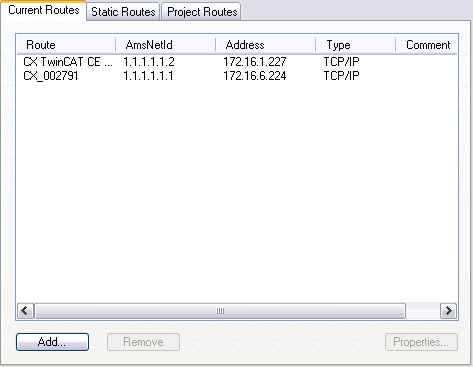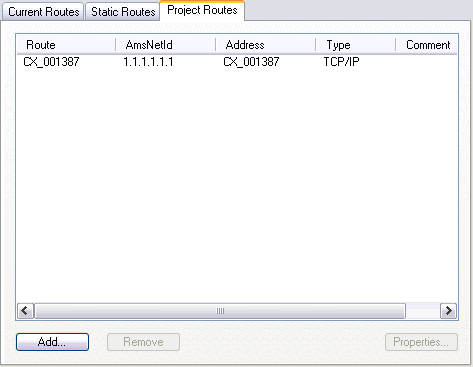Route Settings
Under TwinCAT 2.9 the routing possibilities have been enlarged considerably. For instance TwinCAT doesn't save the routes in the Windows registry, but reads out each addressed router of the desired TwinCAT target-system. Thereby the routes are classified in actual-, static- and project routes. After the connection has linked rsp. the router has been read out, the located routes are collected in the category "static routes" and automatically also in the category "actual routes".
"Current Routes" tab

Route
Shows the name of the TwinCAT target system currently listed at the local TwinCAT Router.
AmsNetID
Displays the ADS-AmsNetId of the listed target system.
Adresse
Shows the ( TCP/IP ) address of the listed target. The address depends on the used transport protokoll. Besides TCP/IP-addresses you also can use addresses of profibus-members etc.. These must support the ADS protocol, to be accessed as "target-system" rsp. "remote-system".
Type
Names the protocol used for this target.
Comment
If configured at the target system, the comment is shown here.
Add
Calls the configuration dialog for adding additional target systems to the local TwinCAT Router.
Remove
Deletes marked entries from the routing table of the local TwinCAT Router.
Properties
Calls the dialog for showing the "Properties" of the target system.
"Static Routes" tab
Static routes are those, which are already configured in the actual addressed router. While the target-system is addressed, the system manager reads out its routes and shows them as a list. When the TwinCAT system manager's projekt file is saved, these static routes are saved too. When you reload the *.tsm file you see them again. Apart from that the "static routes" quasi match the "AMS router" as usual.

For the description of the column headers and buttons, see "Current Route" tab.
"Project Routes" tab

For the description of the column headers and buttons, see "Current Route" tab.